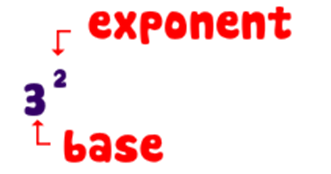- Books Name
- ABCD CLASSES Mathematics Book
- Publication
- ABCD CLASSES
- Course
- CBSE Class 9
- Subject
- Mathmatics
Laws of Exponents or Exponent Rules
What is meant by an exponent? You must have come across the expression 3². Here 3 is the base and 2 is the exponent. Exponents are also called Powers or Indices. The exponent of a number tells how many times to use the number in a multiplication. Let us study the laws of an exponent. It is very important to understand how the laws of exponents laws are formulated.

1. Product law
According to the product law of exponents when multiplying two numbers that have the same base then we can add the exponents
am × an= a m+n
where a, m and n all are natural numbers. Here the base should be the same in both the quantities. For example,
- 2³ × 24 = 27
- 22/3 × 21/5 = 2 2/3 + 1/5 = 2(10+3)/15 . We get, = 212/15
- (-6) 3 x (-6) 2 = (-6) 3+2 = (-6) 5
2. Quotient Law
According to the quotient law of exponents, we can divide two numbers with the same base by subtracting the exponents. In order to divide two exponents that have the same base, subtract the power in the denominator from the power in the numerator.
am ÷ an = a m-n
where a, m and n all are natural numbers. Here the base should be the same in both the quantities. For example,
- 25 ÷ 23 = 2²
- p6 ÷ p2 = p 6 – 2 = p 4
3. Power Law
According to the power law of exponents if a number raise a power to a power, just multiply the exponents
(am)n = am×n
Here there is one base a and two powers m and n. For example, ( 53 )2 = 53×2 = 56
Important Points to Remember on Exponent Rules
- 1an = a-n. A non zero base raised to a negative exponent is equal to the reciprocal of the base raised to the positive exponent or 1a−n = a+n
- a0 = 1. This says that anything raised to the zero power is 1. For example, 50= 1, (1000) 0 = 1
- a1 = a
Power of Product
The power of product rule states that: (ab)m = am × bm, a and b are positive real numbers and m is the rational number. For example, ( 2 × 5)10 = 210 × 510
Power of Quotient
The power of product rule states that:
ab^n = anbn
Or, 25^12 = 212512

 Vision classes
Vision classes
